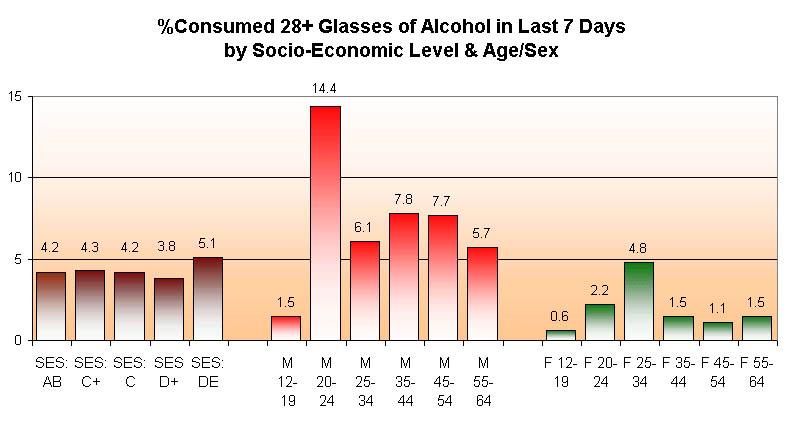
Alcohol Consumption in Mexico
What is alcohol? Alcohol is a compound of carbon, hydrogen and oxygen (C2H5OH) hat is produced when glucose is fermented by yeast. When consumed, alcohol slows down brain activities and induces feelings of relaxation, happiness and euphoria. Alcohol is commercially available in different forms: beer and ale (4-7% alcohol), wine and champagne (9-14%), and hard liquor (40-50%). Throughout history, alcohol has been used by people for festive activities, including religious celebrations.
We will now cite some survey data from the TGI Mexico study. This is a survey of 6,200 persons between the ages of 12 to 64 years old who were interviewed during the first half of 2002. Among these people, 19.7% indicated that they had consumed some form of alcohol such as wine, tequila, rum, whiskey, scotch, vodka, gin, bourbon, port, sherry, etc (but not counting beer).
In the following chart, we show the incidences by socio-economic level and age/sex groups. By socio-economic level, alcohol consumption is higher among the upper- and middle- classes. Among other things, this reflects the cost of alcohol, especially those of the more refined quality. By age/sex, alcohol consumption is significantly higher among adult males, as the ability to hold alcohol may be a badge of manliness.

Alcohol is in fact a highly controversial substance. The alcohol industry has stressed that alcohol has certain health benefits. In the Old and New Testaments, the medicinal properties of alcohol were mentioned 191 times. In Mexico, the legend of tequila began in 1918 when doctors prescribed tequila with salt and lemon to victims of an epidemic of influenza in San Luis Potosí and Zacatecas. Alcohol consumed in moderation is thought to be beneficial in reducing the risk of coronary heart disease. Indeed, alcohol consumption, in conjunction with high intakes of fruit and vegetables, or red wine, may well explain the so-called 'French paradox' --- the French diet is considered to be very high in fat, especially saturated fat, and yet the death rate from coronary heart disease is apparently lower than that of any other developed country.
 |
The proof of the health benefits
of alcohol is not totally convincing in spite of the multiple studies that
have take place over the years. Many of these studies show results
that take the form of U-shaped graphs, with moderate drinkers having the
lowest death rates, while the non-drinkers and heavy drinkers with the highest
death rates (see the figure on the left from Boffetta, P., and
Garefinkel, L. Alcohol drinking among men enrolled in an American Cancer
Society prospective study. Epidemiology, 1990, 1(5), 42-48.).
However, such figures can occur because sick people are more likely to be
non-drinkers --- they do not drink because they are ill, rather than they
become ill because they do not drink.
But the deleterious effects of excessive drinking are not challenged. Alcohol has been linked to a very wide range of other ailments and diseases, such as increased risks of mouth, pharyngeal and stomach cancers; colorectal and breast cancer; high blood pressure; gastrointestinal complications, such as gastritis, ulcers, and liver disease; and a depletion of certain vitamins and minerals are all caused by alcohol consumption. Alcohol intoxication also affects physical motor coordination, as speech becomes slurred, vision blurred, balance is lost and movements turn clumsy. Driving while under the influence of alcohol is a major cause of automobile accidents. |
Excessive alcohol consumption can also have detrimental social and psychological consequences because alcohol is a highly addictive substance. Alcoholism (also known as alcohol dependence) is a disease that includes these characteristics:
The organization Alcoholics Anonymous offers this simple questionnaire:
Four or more positive responses can be taken to indicate the possible existence of an alcohol-related problem.
According to the TGI Mexico study, 4.3% of the survey respondents said they had consumed 28 or more glasses of alcohol in the last 7 days. This translates to an average of four or more glasses of alcohol per day. By socio-economic level, the incidence is almost flat with a slight uptick in the lowest class. By age/sex, it is clear that young male adults are by far the most likely to drink heavily. This is very much a socio-cultural tradition that take the form of drinking contests among male friends.

(posted by Roland Soong, 10/20/2002)
(Return to Zona Latina's Home Page)